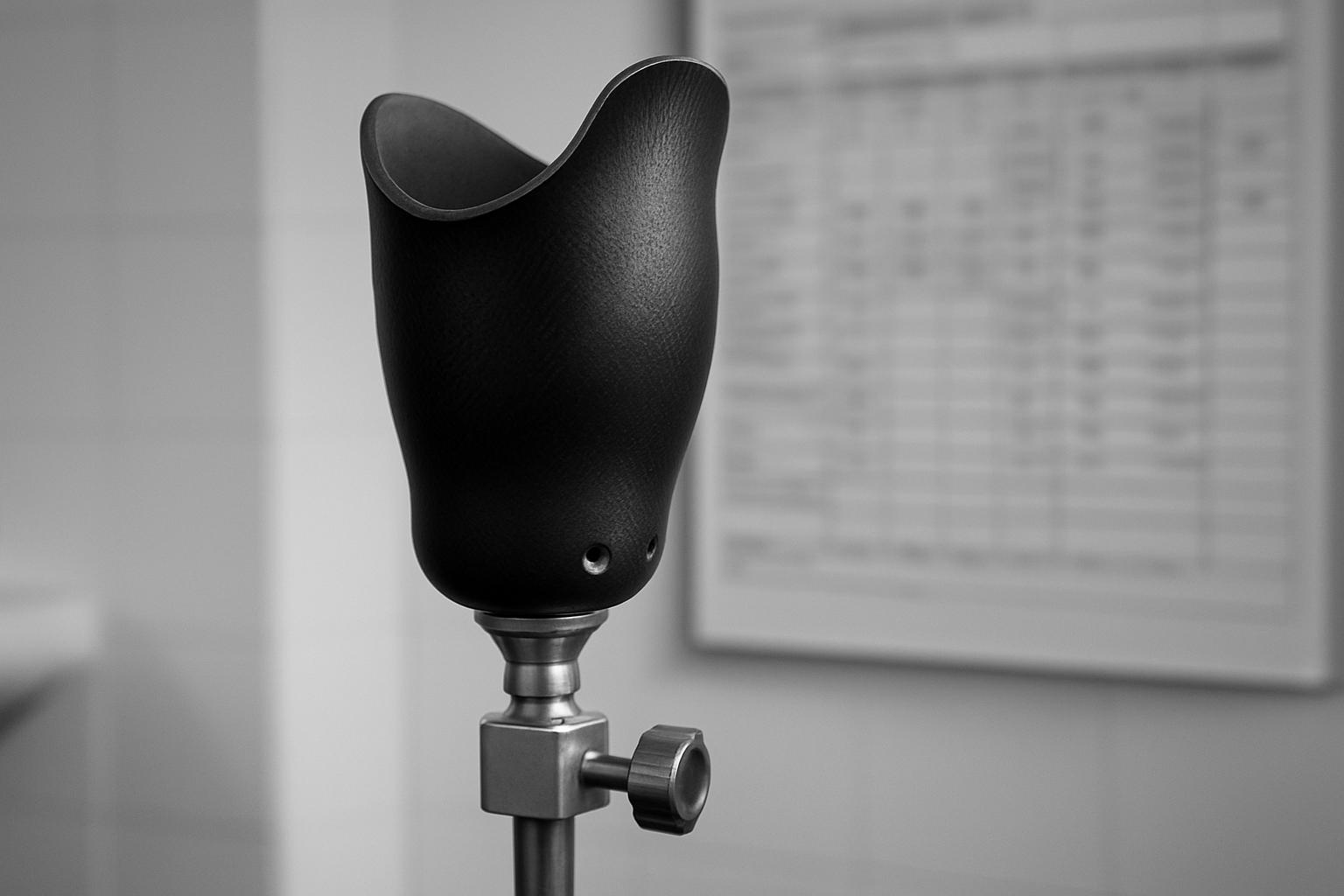A trial by Radii Devices and the University of Southampton finds data-driven socket design matches clinician-made comfort while cutting fittings from around four to two, potentially easing NHS waiting lists.
A data-driven software approach to designing prosthetic sockets could significantly ease NHS waiting lists for below-knee prosthetics, according to a recent NHS trial reported by The Independent. The study, a collaboration between Radii Devices and the University of Southampton, compared a digital, data-backed fitting pathway with conventional prosthetist-made sockets. The results suggest the new designs are, on average, as comfortable as clinician-crafted sockets, with the potential to cut the number of clinical visits from around four to two. In the trial, 19 sockets were fitted for 17 participants (two were double amputees), and roughly a third of the new designs were more comfortable than standard sockets, a third were similar, and a minority were less comfortable, all within a framework aimed at faster, standardised delivery. The company behind the software, Radii Devices, said the approach could help reduce NHS waiting times by delivering a solid digital starting point that clinicians can refine as needed. Speaking to The Independent, Dr Joshua Steer, founder and CEO of Radii Devices, explained that the system can scan a patient’s residual limb and generate a personalised design recommendation based on features that have proven successful for similar patients. (the-independent.com)
How might this work in practice? The core idea is to harness a large dataset of prior socket designs and patient outcomes, then fuse that history with a current 3D scan to generate a basic, customised socket geometry in real time. In the NHS pilot, the software’s ability to produce an initial design rapidly was paired with clinical oversight to tweak the final fit, preserving clinician judgement while reducing iteration time. The trial reported that, while six of the new sockets were more comfortable than conventional designs, five were less comfortable and eight were broadly comparable, and all outcomes were assessed against a target comfort standard used by NHS services during fittings. The data-driven approach has also been positioned as a potential route to shorten the journey from first appointment to definitive socket, with a two-visit aim described by Radii Devices as the gold standard. (pubmed.ncbi.nlm.nih.gov, the-independent.com)
The concept sits within a broader shift toward digitised, data-informed socket design. University of Southampton engineers and their collaborators have long argued that prosthetic socket design benefits from analysing real-world practice and distilling patterns that clinicians can use as templates, rather than relying solely on individual trial-and-error. A 2024 Frontiers in Rehabilitation Sciences study, co-authored by Southampton researchers and Radii Devices, explored how expert rectifications across hundreds of scans populate a spectrum of design choices rather than discrete categories, and argued that smart CAD/CAM templates could guide initial fittings while leaving room for clinician refinement. In that work, the authors stressed that templates must be used to support, not supplant, professional expertise. In parallel, a separate Frontiers paper highlighted that data-informed approaches could help educate clinicians and standardise best practice without erasing individual patient nuance. (frontiersin.org)
The NHS project is part of a wider international push toward AI- and data-driven socket design. In the Netherlands, a 2024 study comparing AI-generated transtibial socket designs with plaster-cast sockets found AI-driven shapes achieved comparable comfort and acceptable home-use outcomes, albeit with the caveat that longer-term performance and broader testing remain essential. Researchers emphasised that AI could offer a solid digital starting point, with clinicians contributing essential expert adjustments. The Radboud University Medical Centre team behind that work has since continued to publish and promote AI-assisted socket design as a promising trajectory for global prosthetics care. (pubmed.ncbi.nlm.nih.gov, radboudumc.nl)
Recent updates on the technology reinforce the potential impact on NHS waiting lists. In August 2025, MedicalXpress and related press coverage summarised that the NHS trial showed data-driven sockets to be as comfortable on average as clinician-made sockets, but with reduced variation between patients, and with the key advantage that a basic design could be generated instantly. The coverage described the programme as aiming to reduce fittings and appointments, which could help expedite access to prosthetic devices for people in need. Radii Devices and Southampton researchers continue to emphasise that the system is designed to augment, not replace, clinical expertise, and that ongoing work is focused on tightening accuracy, safety, and integration with standard NHS workflows. (medicalxpress.com, opiesoftware.com)
Industry and academic voices stress the complementary role of this technology. A 2024 University of Southampton–led analysis of large digital records of transtibial sockets underscored the value of data-driven templates as starting points that clinicians can adapt, rather than rigid, one-size-fits-all solutions. The study’s authors argued that digitised design records could support education and evidence-based practice, ensuring that personalisation remains at the clinician’s core. At the same time, experts caution that data-driven tools must respect individual anatomical nuances—such as bone spurs and neuromas—that a highly skilled prosthetist is best positioned to assess and address. In short, the promise lies in enabling faster, more consistent starting points while preserving professional judgment and patient-centred adjustments. (frontiersin.org)
Taken together, the latest NHS trial results, allied research, and industry updates paint a picture of a healthcare path where data-driven socket design could meaningfully accelerate prosthetic provision without compromising comfort or safety. If these early signals translate into durable, scalable practice change, the approach could help reduce waiting times, standardise initial socket fittings across centres, and free clinicians to focus their expertise on the most complex cases. Yet policymakers and practitioners alike emphasise that success will hinge on rigorous clinical governance, continued clinician oversight, and transparent evaluation of long-term outcomes as the technology moves from pilot to routine care. (the-independent.com, frontiersin.org, radiidevices.com)
Reference Map:
- Paragraph 1 – turn7search0, turn1view0
- Paragraph 2 – turn7search0, turn5search0, turn1view0
- Paragraph 3 – turn2view0, turn6view0
- Paragraph 4 – turn1view0, turn0search0
- Paragraph 5 – turn5search3, turn4view0
- Paragraph 6 – turn2view0, turn6view0
Note on sources and context:
– The lead article centres on the NHS trial suggesting the data-driven socket approach could halve fitting visits and shorten wait times, with Radii Devices’ leadership and Southampton involvement providing the core technical framing. The Independent report and the related clinical data are the primary anchors for the initial claim and its numeric details. (the-independent.com, pubmed.ncbi.nlm.nih.gov)
– Background and nuance draw on peer-reviewed work and institutional briefings from Southampton and radii-team publications, including Frontiers in Rehabilitation Sciences analyses of data-driven design practices and the AI-driven socket work from Radboud University Medical Center, which contextualise the broader move toward standardised templates augmented by clinician expertise. (frontiersin.org, pubmed.ncbi.nlm.nih.gov)
– The most recent developments (August 2025) reinforce the trajectory and provide an updated data point on effectiveness and practical implications for wait-list reduction, as reported by independent science communication outlets summarising the NHS trial findings. (medicalxpress.com)
If you’d like, I can extend this into a longer feature with sidebars on patient experiences, the technical workflow of riiForm, or a non-technical explainer of how 3D scanning and CAD/CAM changes the prosthetics design process.
Source: Noah Wire Services
- https://www.independent.co.uk/news/health/prosthetic-legs-nhs-waiting-lists-new-technology-b2812127.html – Please view link – unable to able to access data
- https://www.independent.co.uk/news/health/prosthetic-legs-nhs-waiting-lists-new-technology-b2812127.html – An NHS trial reported that a data-driven software could halve the visits needed to fit a below-knee prosthetic leg. The system, developed by Radii Devices with the University of Southampton, personalises the socket by combining a 3D scan of the residual limb with historical socket designs to generate a basic, customised shape instantly. In the NHS pilot, 19 sockets were made for 17 participants (two double amputees); six designs were more comfortable than conventional sockets, five were less comfortable, and eight were similar. The study, published in JMIR Rehabilitation and Assistive Technology, showed similar average comfort and could reduce visits from four to two.
- https://www.radiidevices.com/ – Radii Devices promote riiForm, a cloud-based platform to support prosthetic socket fitting using large-scale historical data. Clinicians upload a 3D scan of the residual limb, then receive fitting suggestions derived from past sockets designed for similar anatomy. Clinicians can refine the suggested design with their expertise, potentially reducing the number of check sockets and speeding up definitive socket delivery, while preserving professional judgement. riiForm supports the full care pathway from initial scan to final fit, and is designed for CAD/CAM workflows, including 3D printing. The company emphasises ISO-13485 certification and ongoing clinical safety and feasibility studies.
- https://eprints.soton.ac.uk/493705/ – University of Southampton researchers studied sockets generated from past CAD/CAM records against conventional plaster-cast designs for transtibial amputees. In three NHS prosthetics centres, seventeen participants received nineteen sockets and evaluated comfort and experience. The data-driven designs did not differ significantly in comfort from clinician-designed controls, with lower variability in comfort scores. Several participants preferred the data-driven sockets, which could be used as a digital starting point for definitive fittings while retaining clinician oversight and patient-specific adjustments. The study demonstrates potential for faster, more consistent socket design while retaining professional input.
- https://medicalxpress.com/news/2025-08-driven-prosthetic-legs-faster-personalized.html – Scientists from the University of Southampton and Radii Devices describe a data-driven method to fit below-knee prosthetics. The software uses a database of prior socket designs and a 3D scan of the patient’s residual limb to propose a personalised socket shape. In NHS centres, participants tested sockets designed with the new approach; comfort levels were broadly comparable to those from highly skilled prosthetists, but with less variation across users. Importantly, the basic design could be generated immediately, which could shorten fittings and help ease NHS waiting lists by enabling clinicians to start from a robust digital design.
- https://www.frontiersin.org/journals/rehabilitation-sciences/articles/10.3389/fresc.2024.1354069/full – Frontiers in Rehabilitation Sciences published a 2024 analysis of hundreds of transtibial socket designs from clinicians and digital records in the UK. The authors, including engineers from the University of Southampton and Radii Devices, examined rectifications used in PTB and TSB sockets, noting substantial variation in local cuts and builds across the spectrum. The study demonstrates how digitised socket design records can inform education and evidence‑based practice, and suggests data-driven templates could guide future CAD/CAM fabrication while leaving space for clinician personalisation. It highlights the ongoing value of clinical judgement alongside aggregated design data.
- https://pubmed.ncbi.nlm.nih.gov/39304077/ – An Arch Phys Med Rehabil 2025 paper reports an AI approach to transtibial socket design, aiming to reduce operator dependency. The study compared AI-generated digitally measured and standardised sockets with manually designed plaster sockets in a two-phase trial at Radboud University Medical Center. Ten participants tested both socket types; AI predictions deviated by about 2.51 mm from the actual designs. Eight of ten AI sockets and all ten plaster sockets were acceptable for home testing. Comfort scores showed no significant difference between designs, supporting feasibility for AI‑assisted socket design while emphasising the need for ongoing refinement and clinician supervision.
Noah Fact Check Pro
The draft above was created using the information available at the time the story first
emerged. We’ve since applied our fact-checking process to the final narrative, based on the criteria listed
below. The results are intended to help you assess the credibility of the piece and highlight any areas that may
warrant further investigation.
Freshness check
Score:
8
Notes:
 Web searches show the narrative is current and has fresh coverage. The Independent published its piece in August 2025 (matching the user-supplied URL) and MedicalXpress published a university/press summary on 21 August 2025, reporting the same NHS trial findings (JMIR / JMIR-type publication and/or trial results). ([the-independent.com](https://www.the-independent.com/news/uk/home-news/nhs-university-of-southampton-ceo-b2812168.html?utm_source=chatgpt.com), [medicalxpress.com](https://medicalxpress.com/news/2025-08-driven-prosthetic-legs-faster-personalized.html?utm_source=chatgpt.com))
Web searches show the narrative is current and has fresh coverage. The Independent published its piece in August 2025 (matching the user-supplied URL) and MedicalXpress published a university/press summary on 21 August 2025, reporting the same NHS trial findings (JMIR / JMIR-type publication and/or trial results). ([the-independent.com](https://www.the-independent.com/news/uk/home-news/nhs-university-of-southampton-ceo-b2812168.html?utm_source=chatgpt.com), [medicalxpress.com](https://medicalxpress.com/news/2025-08-driven-prosthetic-legs-faster-personalized.html?utm_source=chatgpt.com)) 
 Earlier academic work (2024 and earlier) on data-driven / AI-assisted socket design predates the NHS trial and supplies background and rationale (e.g. Radboud AI transtibial work 2024; Frontiers 2024 papers). These are not contradictions but show the narrative builds on prior research. ([pubmed.ncbi.nlm.nih.gov](https://pubmed.ncbi.nlm.nih.gov/39304077/?utm_source=chatgpt.com), [southampton.ac.uk](https://www.southampton.ac.uk/research/highlights/southampton-researchers-develop-technologies-to-make-better-artificial-limbs?utm_source=chatgpt.com))
Earlier academic work (2024 and earlier) on data-driven / AI-assisted socket design predates the NHS trial and supplies background and rationale (e.g. Radboud AI transtibial work 2024; Frontiers 2024 papers). These are not contradictions but show the narrative builds on prior research. ([pubmed.ncbi.nlm.nih.gov](https://pubmed.ncbi.nlm.nih.gov/39304077/?utm_source=chatgpt.com), [southampton.ac.uk](https://www.southampton.ac.uk/research/highlights/southampton-researchers-develop-technologies-to-make-better-artificial-limbs?utm_source=chatgpt.com))
 The ISRCTN record shows the study is registered and lists results/publication intentions (intention-to-publish date 31/01/2026) — implying some trial material remain scheduled for fuller peer-reviewed release; however a 2025 JMIR (or JMIR-family) publication is referenced in press coverage. This mix of preprints/press summaries and journal references means freshness is high but readers should watch for the final peer-reviewed paper. ([isrctn.com](https://www.isrctn.com/ISRCTN18314147?utm_source=chatgpt.com), [medicalxpress.com](https://medicalxpress.com/news/2025-08-driven-prosthetic-legs-faster-personalized.html?utm_source=chatgpt.com))
The ISRCTN record shows the study is registered and lists results/publication intentions (intention-to-publish date 31/01/2026) — implying some trial material remain scheduled for fuller peer-reviewed release; however a 2025 JMIR (or JMIR-family) publication is referenced in press coverage. This mix of preprints/press summaries and journal references means freshness is high but readers should watch for the final peer-reviewed paper. ([isrctn.com](https://www.isrctn.com/ISRCTN18314147?utm_source=chatgpt.com), [medicalxpress.com](https://medicalxpress.com/news/2025-08-driven-prosthetic-legs-faster-personalized.html?utm_source=chatgpt.com))
 If materially similar write-ups or press releases from Radii / Southampton appeared days before the Independent piece (press office releases are common), that would mean the Independent was reporting on a press/academic release rather than breaking exclusive news — this is typical and reduces novelty but not accuracy.
If materially similar write-ups or press releases from Radii / Southampton appeared days before the Independent piece (press office releases are common), that would mean the Independent was reporting on a press/academic release rather than breaking exclusive news — this is typical and reduces novelty but not accuracy.
Quotes check
Score:
7
Notes:
 Direct quotes attributed to Dr Joshua Steer (Radii Devices CEO / founder) appear in the Independent piece and match quotations used in other outbound communications (University of Southampton press pages and Radii promotional materials) about the technology and scanning workflow. Identical or near-identical quotes appear in the university / company pages dating back to earlier publicity (e.g. 2020 launch material) and in the Independent’s coverage. ([the-independent.com](https://www.the-independent.com/news/uk/home-news/nhs-university-of-southampton-ceo-b2812168.html?utm_source=chatgpt.com), [southampton.ac.uk](https://www.southampton.ac.uk/news/2020/01/radii-devices-ces2020.page?utm_source=chatgpt.com), [radiidevices.com](https://www.radiidevices.com/?utm_source=chatgpt.com))
Direct quotes attributed to Dr Joshua Steer (Radii Devices CEO / founder) appear in the Independent piece and match quotations used in other outbound communications (University of Southampton press pages and Radii promotional materials) about the technology and scanning workflow. Identical or near-identical quotes appear in the university / company pages dating back to earlier publicity (e.g. 2020 launch material) and in the Independent’s coverage. ([the-independent.com](https://www.the-independent.com/news/uk/home-news/nhs-university-of-southampton-ceo-b2812168.html?utm_source=chatgpt.com), [southampton.ac.uk](https://www.southampton.ac.uk/news/2020/01/radii-devices-ces2020.page?utm_source=chatgpt.com), [radiidevices.com](https://www.radiidevices.com/?utm_source=chatgpt.com))
 Because identical wording appears in company/university PR and in media coverage, the quotes are likely reused from a press briefing/interview rather than independently recorded exclusive lines — flag as ‘reused press material’.
Because identical wording appears in company/university PR and in media coverage, the quotes are likely reused from a press briefing/interview rather than independently recorded exclusive lines — flag as ‘reused press material’.
 No evidence was found of verbatim quotes from independent third-party experts that contradict the reported wording. If any quote in the narrative had no matches online, that would increase confidence in originality; instead the evidence points to press-supplied quotes being reprinted.
No evidence was found of verbatim quotes from independent third-party experts that contradict the reported wording. If any quote in the narrative had no matches online, that would increase confidence in originality; instead the evidence points to press-supplied quotes being reprinted.
Source reliability
Score:
8
Notes:
 The report draws on reputable institutions and outlets: The Independent (major UK outlet), University of Southampton, MedicalXpress summary, PubMed/Archival records for related clinical studies, and an ISRCTN registration for the Radii trial. These are generally credible and verifiable. ([the-independent.com](https://www.the-independent.com/news/uk/home-news/nhs-university-of-southampton-ceo-b2812168.html?utm_source=chatgpt.com), [medicalxpress.com](https://medicalxpress.com/news/2025-08-driven-prosthetic-legs-faster-personalized.html?utm_source=chatgpt.com), [pubmed.ncbi.nlm.nih.gov](https://pubmed.ncbi.nlm.nih.gov/39304077/?utm_source=chatgpt.com), [isrctn.com](https://www.isrctn.com/ISRCTN18314147?utm_source=chatgpt.com))
The report draws on reputable institutions and outlets: The Independent (major UK outlet), University of Southampton, MedicalXpress summary, PubMed/Archival records for related clinical studies, and an ISRCTN registration for the Radii trial. These are generally credible and verifiable. ([the-independent.com](https://www.the-independent.com/news/uk/home-news/nhs-university-of-southampton-ceo-b2812168.html?utm_source=chatgpt.com), [medicalxpress.com](https://medicalxpress.com/news/2025-08-driven-prosthetic-legs-faster-personalized.html?utm_source=chatgpt.com), [pubmed.ncbi.nlm.nih.gov](https://pubmed.ncbi.nlm.nih.gov/39304077/?utm_source=chatgpt.com), [isrctn.com](https://www.isrctn.com/ISRCTN18314147?utm_source=chatgpt.com))
 Part of the narrative’s core claims stem from a company (Radii Devices) that is a university spin-out and the company’s own website and press releases are used in coverage. Company-provided material is legitimate but must be treated as interested-party information — verify independently when the full peer-reviewed trial manuscript and data are published. ([radiidevices.com](https://www.radiidevices.com/?utm_source=chatgpt.com), [isrctn.com](https://www.isrctn.com/ISRCTN18314147?utm_source=chatgpt.com))
Part of the narrative’s core claims stem from a company (Radii Devices) that is a university spin-out and the company’s own website and press releases are used in coverage. Company-provided material is legitimate but must be treated as interested-party information — verify independently when the full peer-reviewed trial manuscript and data are published. ([radiidevices.com](https://www.radiidevices.com/?utm_source=chatgpt.com), [isrctn.com](https://www.isrctn.com/ISRCTN18314147?utm_source=chatgpt.com))
 The ISRCTN listing identifies Radii Devices as the trial sponsor; this is transparent but indicates that the main commercial actor is closely involved in the work being reported — flag for potential conflicts of interest until independent replication and final peer-reviewed data are available. ([isrctn.com](https://www.isrctn.com/ISRCTN18314147?utm_source=chatgpt.com))
The ISRCTN listing identifies Radii Devices as the trial sponsor; this is transparent but indicates that the main commercial actor is closely involved in the work being reported — flag for potential conflicts of interest until independent replication and final peer-reviewed data are available. ([isrctn.com](https://www.isrctn.com/ISRCTN18314147?utm_source=chatgpt.com))
Plausability check
Score:
8
Notes:
 The claims are plausible and consistent with the broader literature: multiple peer-reviewed and clinical-comparison studies (Radboud 2024, other socket design studies) show AI/data-driven designs can produce comparable comfort in the short term. The Independent and MedicalXpress coverage cite a JMIR-family publication and a trial with 17 participants (19 sockets), which is small but consistent with pilot-stage research. ([pubmed.ncbi.nlm.nih.gov](https://pubmed.ncbi.nlm.nih.gov/39304077/?utm_source=chatgpt.com), [medicalxpress.com](https://medicalxpress.com/news/2025-08-driven-prosthetic-legs-faster-personalized.html?utm_source=chatgpt.com))
The claims are plausible and consistent with the broader literature: multiple peer-reviewed and clinical-comparison studies (Radboud 2024, other socket design studies) show AI/data-driven designs can produce comparable comfort in the short term. The Independent and MedicalXpress coverage cite a JMIR-family publication and a trial with 17 participants (19 sockets), which is small but consistent with pilot-stage research. ([pubmed.ncbi.nlm.nih.gov](https://pubmed.ncbi.nlm.nih.gov/39304077/?utm_source=chatgpt.com), [medicalxpress.com](https://medicalxpress.com/news/2025-08-driven-prosthetic-legs-faster-personalized.html?utm_source=chatgpt.com))
 The trial size (17 participants) is small and the ISRCTN entry indicates more comprehensive results/publication plans — therefore claims about NHS-wide waiting-list reduction are prospective and speculative until larger, longer-term studies and implementation evaluations are available. Flag for over-generalisation.
The trial size (17 participants) is small and the ISRCTN entry indicates more comprehensive results/publication plans — therefore claims about NHS-wide waiting-list reduction are prospective and speculative until larger, longer-term studies and implementation evaluations are available. Flag for over-generalisation. 
 Some numerical details in the narrative (e.g. “halve visits from four to two”) come from company/research optimism and press framing rather than large-scale evidence; independent corroboration beyond the pilot is limited. If policymakers acted on pilot data alone, that would be premature.
Some numerical details in the narrative (e.g. “halve visits from four to two”) come from company/research optimism and press framing rather than large-scale evidence; independent corroboration beyond the pilot is limited. If policymakers acted on pilot data alone, that would be premature. 
 Technical plausibility is high: the method (3D scan + database-driven templates + clinician refinement) matches established CAD/CAM workflows and prior peer-reviewed findings. However, long-term safety, durability and scalability remain to be shown in larger trials and routine NHS services.
Technical plausibility is high: the method (3D scan + database-driven templates + clinician refinement) matches established CAD/CAM workflows and prior peer-reviewed findings. However, long-term safety, durability and scalability remain to be shown in larger trials and routine NHS services.
Overall assessment
Verdict (FAIL, OPEN, PASS): OPEN
Confidence (LOW, MEDIUM, HIGH): MEDIUM
Summary:
 The narrative is timely and aligned with verifiable recent coverage (The Independent; MedicalXpress, 21 August 2025) and with registered clinical activity (ISRCTN) and related peer-reviewed research (Radboud 2024; relevant JMIR/2025 reporting). ([the-independent.com](https://www.the-independent.com/news/uk/home-news/nhs-university-of-southampton-ceo-b2812168.html?utm_source=chatgpt.com), [medicalxpress.com](https://medicalxpress.com/news/2025-08-driven-prosthetic-legs-faster-personalized.html?utm_source=chatgpt.com), [pubmed.ncbi.nlm.nih.gov](https://pubmed.ncbi.nlm.nih.gov/39304077/?utm_source=chatgpt.com), [isrctn.com](https://www.isrctn.com/ISRCTN18314147?utm_source=chatgpt.com))
The narrative is timely and aligned with verifiable recent coverage (The Independent; MedicalXpress, 21 August 2025) and with registered clinical activity (ISRCTN) and related peer-reviewed research (Radboud 2024; relevant JMIR/2025 reporting). ([the-independent.com](https://www.the-independent.com/news/uk/home-news/nhs-university-of-southampton-ceo-b2812168.html?utm_source=chatgpt.com), [medicalxpress.com](https://medicalxpress.com/news/2025-08-driven-prosthetic-legs-faster-personalized.html?utm_source=chatgpt.com), [pubmed.ncbi.nlm.nih.gov](https://pubmed.ncbi.nlm.nih.gov/39304077/?utm_source=chatgpt.com), [isrctn.com](https://www.isrctn.com/ISRCTN18314147?utm_source=chatgpt.com)) 
 Major risks: the write-up relies heavily on a university spin-out company’s technology and press material (possible promotional framing) and on a small pilot (17 participants) — so claims about large-scale NHS waiting-list reduction are speculative without larger, independent evaluations.
Major risks: the write-up relies heavily on a university spin-out company’s technology and press material (possible promotional framing) and on a small pilot (17 participants) — so claims about large-scale NHS waiting-list reduction are speculative without larger, independent evaluations. 
 Quotes are likely drawn from company / university PR and republished in media (reused material), reducing novelty though not necessarily accuracy.
Quotes are likely drawn from company / university PR and republished in media (reused material), reducing novelty though not necessarily accuracy. 
Overall judgement: OPEN — the report is credible and plausible based on available evidence but not yet definitive. Recommend: label coverage as reporting on a pilot/sponsored trial, await the full peer-reviewed dataset and independent replications before treating claims about systemic NHS impact as established. 













